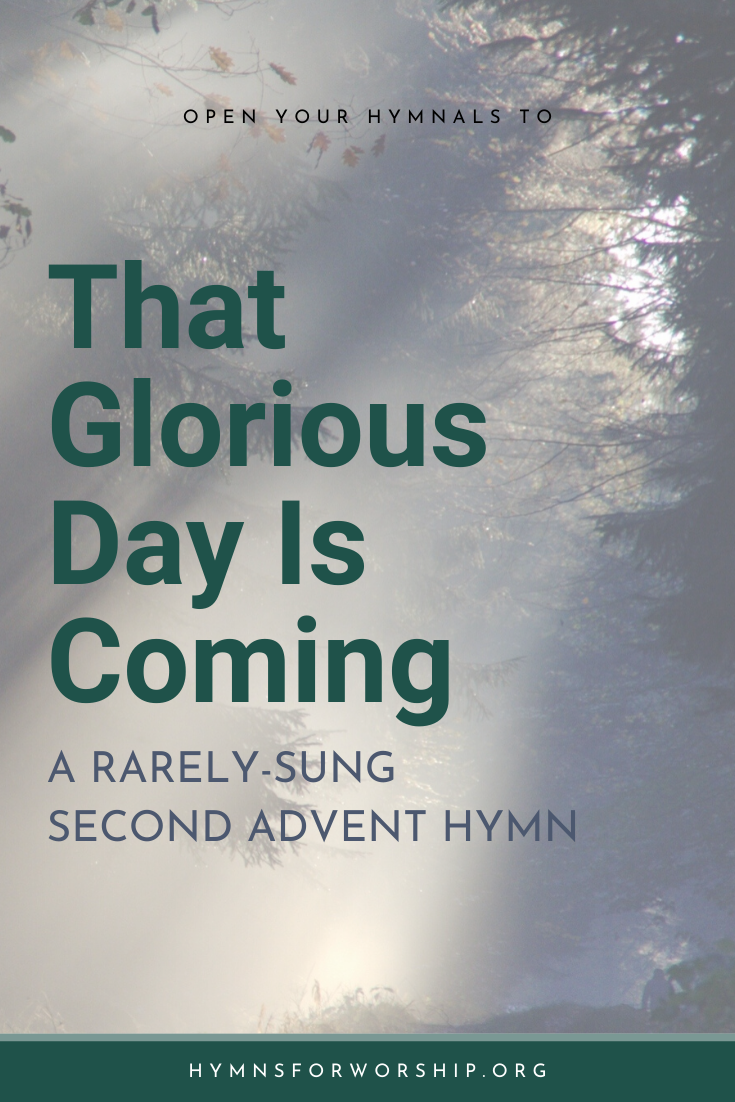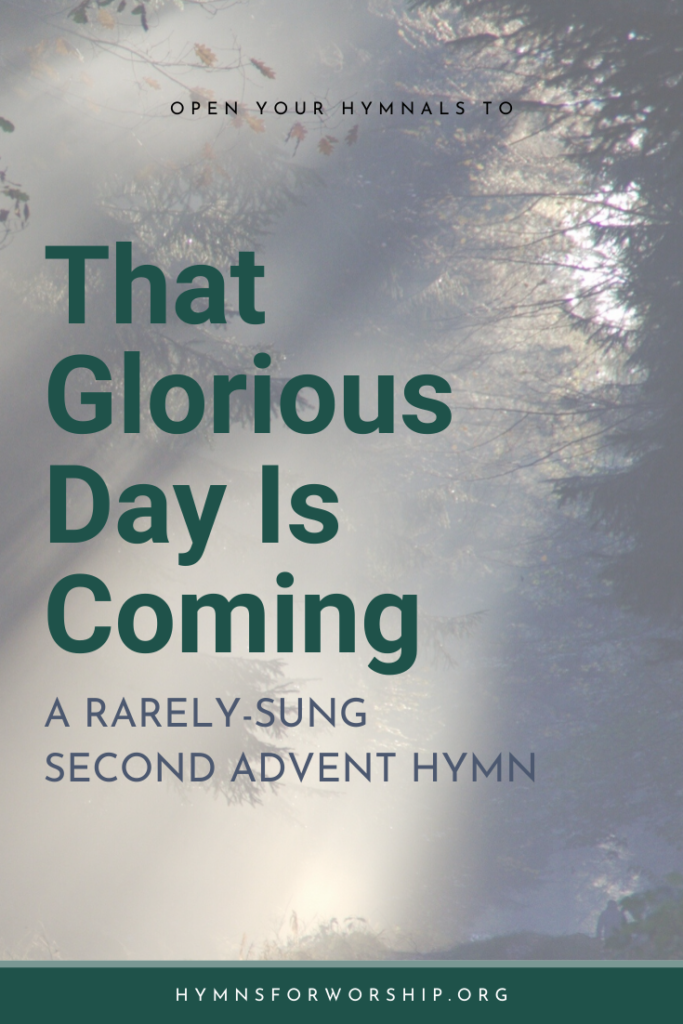
Many Adventists are familiar with the story of William Miller’s discovery of the partially correct, but extremely crucial, interpretation of Daniel 8:14. We all know of how he made a promise to God about sharing this message to people, only if invited to preach.
For eight years, Miller was true to his promise. His itinerary kept him busy as he preached in small churches in little towns. But during the fall of 1839, he met a man who was extremely influential in changing the course of his career.
What are you doing to spread it to the world?
This man was Joshua V. Himes, then prominently active in the educational, temperance, peace, and
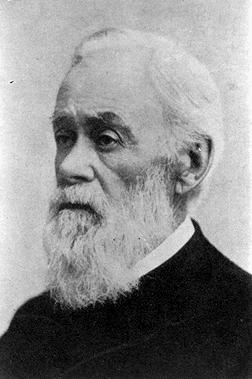
abolitionist reform movements of the day. Hearing Miller speak about the 2300 days in Exeter, New Hampshire, he was very impressed and invited the preacher to repeat his sermon in Boston.
Deeply impressed by the messages Miller shared, Himes inquired one night, “Do you really believe what you have been preaching to us?” To this, the humble preacher replied, “I most certainly do. Brother Himes, or I would not be preaching it.”
The next question surprised Miller. “Then what are you doing to spread it through the world?” When Miller recounted to Himes the little village churches he had visited, Himes was filled with shock and concern.
“What about the big cities? Should they go unwarned? And what about the rest of the world?” Himes’ mind raced as he looked at the enormity of the task. “If Christ is to come in a few years as you believe, there is no time lose in sending out the message in thundertones to arouse them to prepare!”
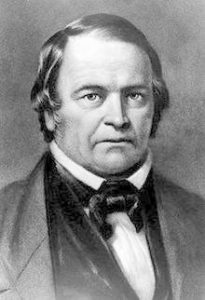
From that point onwards, Himes expended all that he can — himself, his family and his reputation. He resolved to himself that he would help Miller spread this message to the limits of his power. C. Mervyn Maxwell described him as, “Miller’s manager, advertising agent, and consecrated promotion specialist.”
J.V. Himes — A Man of Action
Dynamic contributions poured forth from Himes. One of the ways he extensivley expanded the ministry was through publications, one of which was called the Signs of the Times. Many Protestant churches swelled with new members as the tidings of Christ’s soon return was disseminated.
Camp meetings were being held in many places. Maxwell relates Joesph Bates’ account of the scene in his book Tell It To the World:
“Men, women and children flocked in from every direction, crowding steamboats, overflowing railroad cars, and jamming stagecoaches; pedestrians trudged in from every side of the road, as one and all, the pious and the curious, made their way to the important meetings at the second advent campground. It seemed every believer carried a Bible in his hand.”
What Maxwell failed to mention was that in these great gatherings, a powerful singing emanated from the campgrounds. Eyewitness accounts reported that they would hear such hymns sung that held them in breathless attention.
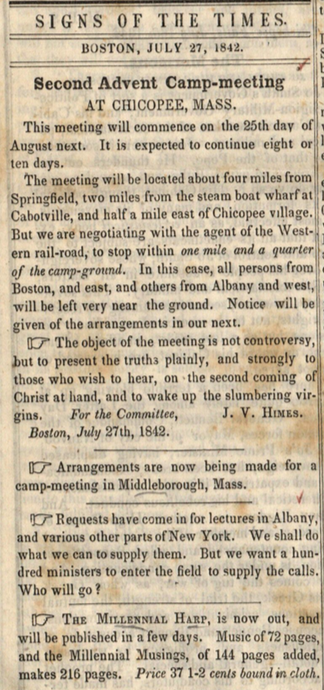
These tent meetings induced Himes to produce a hymnal that will perfectly accompany the timely messages of Miller. A man of action, Himes included hymnal-related advertisements in the Signs from the years 1841-1842.
“Millennial Musings: A selection of soul-stirring hymns and spiritual songs, from various authors, relative to the return of the Lord, and the preparation of His saints to meet Him in peace. It is designed for Second Advent meetings for prayer and conference. It will be out the 8th of October.”
“HYMN BOOKS. ‘Millennial Musings. — A choice selection of hymns designed for the use of Second Advent Meetings.” By J.V. Himes and J. Litch. Price $2.40 per dozen, 20 cents single.
“The Millennial Harp, is now out, and will be published in a few days. Music of seventy-two pages, and the Millennial Musings, one one hundred forty-four pages added, make two hundred sixteen pages.
Inclusion of the hymn in the Adventist hymnody
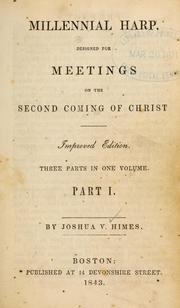
It was in Millennial Harp that the hymn, “That Glorious Day Is Coming” first appeared. It was one of those hymns that did not include a tune, but just an annotation of its meter, 7.6.7.6.
In previous older hymnals published in the late 1850s and early 1900s, several hymn editors used the tune ANGEL’S STORY (SDAH 331 – O Jesus I Have Promised), another hymnal uses a tune by an L. Mason (Lowell Mason?).
The 1985 SDA Hymnal Committee wanted to reinstate the hymn back to the Adventist hymnal and requested that an original tune be composed for it. Melvin West’s CHEROKEE LANE was selected. As to why West chose that tune name, he wrote that it was simply after the name of a memorial park in Lodi California of which his father was a president.
Listen to a wonderful rendition of this hymn by Alessandra Sorace
Textual changes
When I checked the actual hymn in the Millenial Harp, I saw some obvious changes that were made here’s a comparison of the texts.
1985 SDA Hymnal
That glorious day is coming,
The hour is hastening on;
Its radiant light is nearing,
Far brighter than the sun;
In yonder clouds of heaven,
The Savior will appear,
And gather all His chosen,
to meet him in the air.
The saints then all victorious,
Will go to meet their Lord;
An earth both bright and glorious,
Will then be their reward;
And God himself there reigning,
Will wipe all tears away;
Nor clouds nor night remaining,
But one eternal day.
O Christian, keep from sleeping,
And let your love abound;
Be watchful, prayerful, faithful,
The trumpet soon will sound!
O sinner, hear the warning!
To Jesus quickly fly!
Then you, in that blest morning,
May meet Him in the sky!
1843 Millennial Harp
The glorious day is coming,
The hour is rolling on;
Its radiant light is beaming,
Resplendent as the sun;
In yon bright clouds of heaven,
The Savior will appear,
And gather all His chosen,
To meet him in the air.
Then fire, from God descending,
Shall sweep this wide earth o’er,
And nations, loud lamenting,
Shall sink to rise no more.
Though tears with groans are blended,
Yet still in vain they cry;
The day of hope is ended,
The sinner now must die
But saints shall be victorious,
And joy to meet the Lord;
An earth more bright and glorious,
Is promised in his word.
Our God himself, there reigning,
Shall wipe all tears away;
Nor clouds or night remaining,
But one eternal day.
O Christian! wake from sleeping,
And let your works abound;
Be watching, praying, weeping,
For soon the trump will sound!
O sinner! hear the warning,
TO JESUS QUICKLY FLY!
Then you, on that blest morning,
May meet Him in the sky.
One very obvious change was that the second stanza was wholly omitted. As to why that was, I would not fully know. But I can only guess that it is because of the strong language and imagery that the anonymous hymn writer used.
A paper written by Lyell Heise examined the theology and history behind the 1849 Hymnal that James White put out. He made a comparison about the inclusion of distinct Adventist hymns in the 1849 Hymnal that did not make it to the most current SDA Hymnal. His conclusion was:
“…either editors did not feel that its literary standard was sufficiently high, or they felt that it was too apocalyptic in tone to suit the needs of later…
Hence I can only guess whether that could be the same reason as to why the second stanza was omitted.
Another interesting change is in the second line of the final stanza:
Original: And let your works abound
Recent: And let your love abound
We can discuss the faith and works issue some other time, but it is just interesting to note that very important editorial change.
Do you know this hymn?
The sad fact though is that I’ve never been to an Adventist church that sang this hymn. What a wasted blessing it is to have access to hymns that are deeply rooted in our heritage, and yet it is scarcely sung.
If you find Melvin West’s CHEROKEE LANE too hard to learn (although I think he really did a good job in reflecting the message of the song), then sing it to the more familiar ANGEL’S STORY. Whichever way you sing it, let this hymn renew your longing for Christ’s soon return!
*This post contains affiliate links
Like this article? Share it!

